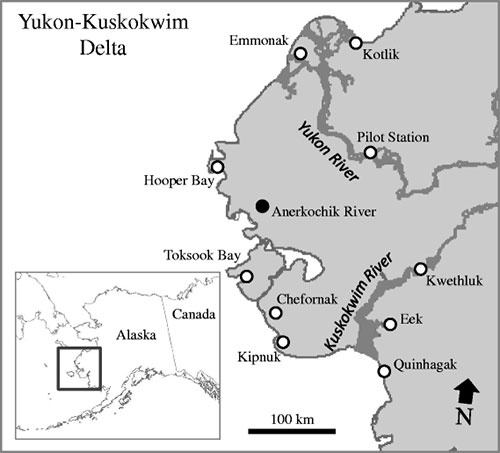
Alaska Still a Likely Portal for Avian Influenza
April 11, 2016
“Our past research in western Alaska has shown that while we have not detected the highly pathogenic avian influenza virus, up to 70 percent of the other avian influenza viruses isolated in this area were found to contain genetic material from Eurasia, providing evidence for high levels of intercontinental viral exchange,” said Andy Ramey, a scientist with the USGS and lead author of the recent report. “This is because Asian and North American migratory flyways overlap in western Alaska.”
Map of the Yukon-Kuskowim Delta, Alaska and approximate locations for wild bird surveillance sampling for Eurasian lineage and intercontinental reassortant highly pathogenic influenza A viruses during spring (open circles) and summer (darkened circle) 2015
Past research by the USGS, found low pathogenic H9N2 viruses in an Emperor Goose and a Northern Pintail. Both viruses were nearly identical genetically to viruses found in wild bird samples from Lake Dongting, China and Cheon-su Bay, South Korea. “These H9N2 viruses are low pathogenic and not known to infect humans, but similar viruses have been implicated in disease outbreaks in domestic poultry in Asia,” said Ramey. In the new report, the USGS collaborated with the Yukon Kuskokwim Health Corporation in Bethel, Alaska, and the Southeastern Cooperative Wildlife Disease Study in Athens, Georgia to obtain and test bird samples from Alaska Native subsistence hunters during spring of 2015. Hunters provided researchers with over 1,000 swabs from harvested water birds, the primary hosts of avian influenza viruses. Last year, the USGS published an article describing the introduction of highly pathogenic avian influenza into North America at the end of 2014, likely via migratory birds that migrated through Alaska. However, highly pathogenic avian influenza was never documented in Alaska. The highly pathogenic viruses spread throughout parts of the western and Midwestern U.S., impacting approximately 50 million poultry. However, those highly pathogenic viruses have now not been detected in North America since July 2015. This fall, the USGS will sample wild birds at Izembek National Wildlife Refuge. Most of those samples will come from sport hunters. The new report is entitled, “Surveillance for Eurasian-origin and intercontinental reassortant highly pathogenic influenza A viruses in Alaska, spring and summer 2015” and is published in Virology Journal.
Edited by Mary Kauffman, SitNews
Source of News:
Representations of fact and opinions in comments posted below are solely those of the individual posters and do not represent the opinions of Sitnews.
|
||
